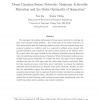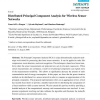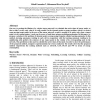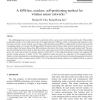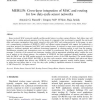CORR
2006
Springer
2006
Springer
Dense Gaussian Sensor Networks: Minimum Achievable Distortion and the Order Optimality of Separation
13 years 4 months ago
We investigate the optimal performance of dense sensor networks by studying the joint source-channel coding problem. The overall goal of the sensor network is to take measurements...
CORR
2010
Springer
13 years 4 months ago
2010
Springer
For a sensor network, as tractable spatially-dependent node deployment model is presented with the property that the density is inversely proportional to the sink distance. A stoc...
CORR
2010
Springer
13 years 4 months ago
2010
Springer
Abstract: The Principal Component Analysis (PCA) is a data dimensionality reduction technique well-suited for processing data from sensor networks. It can be applied to tasks like ...
CN
2008
13 years 4 months ago
2008
Wireless sensor networks enhance our ability to monitor the physical world. Many recent researches on wireless sensor networks have focused on aspects such as routing, node cooper...
CONCURRENCY
2010
13 years 4 months ago
2010
Communication through relay channels in wireless sensor networks can create diversity and consequently improve robustness of data transmission for ubiquitous computing and network...
AHSWN
2010
13 years 4 months ago
2010
One way to prolong the lifetime of a wireless sensor network is to schedule the active times of sensor nodes, so that a node is active only when it is really needed. In the dynami...
ADHOC
2007
13 years 4 months ago
2007
— The problem of congestion in sensor networks is significantly different from conventional ad-hoc networks and has not been studied to any great extent thus far. In this paper,...
ADHOC
2007
13 years 4 months ago
2007
One challenging issue in sensor networks is to determine where a given sensor node is physically located. This problem is especially crucial for very small sensor nodes. This pape...
ADHOC
2008
13 years 4 months ago
2008
Sensor network MAC protocols typically sacrifice packet latency to achieve energy efficiency. Such delays may well increase due to routing protocol operation. For this reason it i...
CISIS
2008
IEEE
13 years 4 months ago
2008
IEEE
A major issue in wireless sensor networks is to prolong network lifetime by efficient energy management. In this paper we present an initial study of maximum lifetime routing in s...
